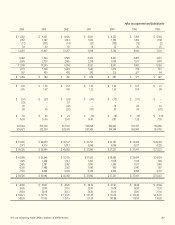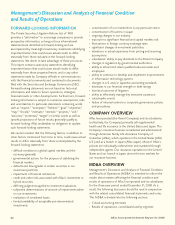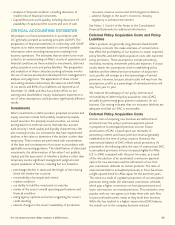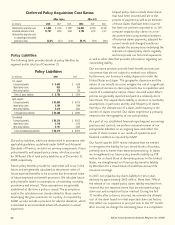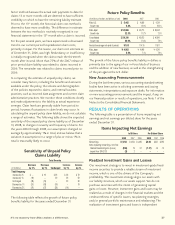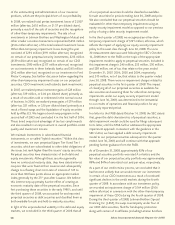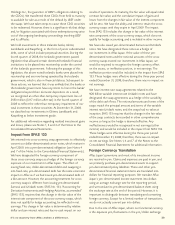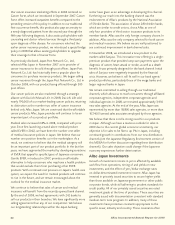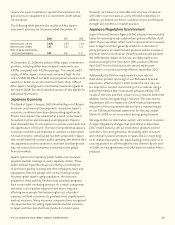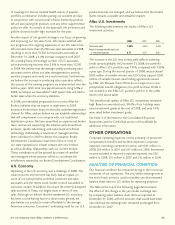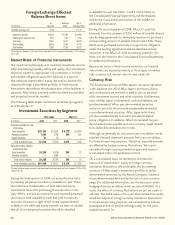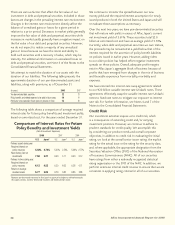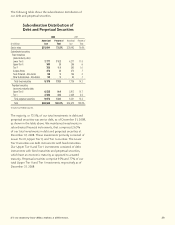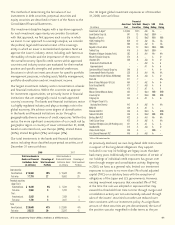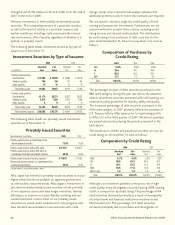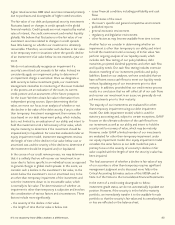Aflac 2008 Annual Report Download - page 37
Download and view the complete annual report
Please find page 37 of the 2008 Aflac annual report below. You can navigate through the pages in the report by either clicking on the pages listed below, or by using the keyword search tool below to find specific information within the annual report.
33
It’s no mystery how Aflac makes a difference.
require the issuer to adhere to specific financial ratios and
give priority to repayment of our investment under certain
circumstances.
The following table presents the results of Aflac Japan’s
investment activities for the years ended December 31.
At December 31, 2008, the yield on Aflac Japan’s investment
portfolio, including dollar-denominated investments, was
3.90%, compared with 4.02% a year ago. The overall credit
quality of Aflac Japan’s investments remained high. At the
end of 2008, 80.9% of our debt and perpetual securities were
rated A or better on an amortized cost basis. Only 1.9% of
Aflac Japan’s holdings were rated below investment grade at
the end of 2008. See the Credit Risk section of this MD&A for
additional information.
Japanese Economy
The Bank of Japan’s January 2009 Monthly Report of Recent
Economic and Financial Developments stated that Japan’s
economic conditions have been deteriorating significantly.
Private consumption has weakened as a result of decreased
household income and increased unemployment. Exports
have decreased due to a slowdown in overseas economies and
the appreciation of the yen. The report projected that Japan’s
economic conditions are expected to continue to deteriorate.
A broad economic stimulus plan has been proposed in Japan
that would hopefully increase public spending. We believe that
the Japanese economic situation is uncertain and that growth
may not return until confidence is restored to the global
financial markets.
Japan’s system of compulsory public health care insurance
provides medical coverage to every Japanese citizen. These
public medical expenditures are covered by a combination
of premiums paid by insureds and their employers, taxes and
copayments from the people who receive medical service.
However, given Japan’s aging population, the resources
available to these publicly funded social insurance programs
have come under increasing pressure. As a result, copayments
and other out-of-pocket expenses have been rising and
affecting more people. We believe higher out-of-pocket
expenses will lead consumers to purchase more supplemental
medical insurance. Many insurance companies have recognized
the opportunities for selling supplemental medical insurance
in Japan and have launched new products in recent years.
However, we believe our favorable cost structure compared
with other insurers makes us a very effective competitor. In
addition, we believe our brand, customer service and financial
strength also benefit our market position.
Japanese Regulatory Environment
Japan’s Financial Services Agency (FSA) adopted new mortality
tables for reserving newly underwritten policies effective April
2007. These new tables reflect recent improvements in survival
rates in Japan and have generally resulted in a decrease in
policy premiums for death benefit products and an increase in
premium rates for third sector (health) products and annuities.
We reflected the impact of the new mortality table in our
product pricing for the first sector (life) products effective
April 2007. For the third sector, the revised tables were
reflected in our product pricing effective September 2007.
Additionally, the FSA has implemented a new rule for
third sector product reserving for our FSA-based financial
statements, effective April 1, 2007. Under the new rule, we
are required to conduct stress testing of our reserves using a
prescribed method that incorporates actual morbidity. The
results of the tests and their relation to our reserves determine
whether reserve strengthening is required. This new reserve
requirement will not impact our GAAP financial statements.
Adoption of this requirement did not have a material impact
on our FSA-based financial statements for the year ended
March 31, 2008, or on our product pricing going forward.
We expect that our distribution system will continue to evolve
in Japan. Regulatory changes that took effect in December
2007 enable banks to sell our third sector products to their
customers. Our strong brand as the leading seller of cancer
and medical insurance products in Japan and our many long-
term relationships within the Japan banking sector place us in
a strong position to sell through this new channel. By the end
of 2008, we had agreements with 242 banks to market Aflac’s
products.
2008 2007 2006
New money yield - yen only 3.20% 3.05% 3.10%
New money yield - blended 3.43 3.38 3.33
Return on average invested assets,
net of investment expenses 3.82 4.06 4.11


